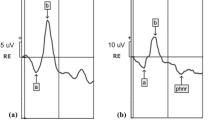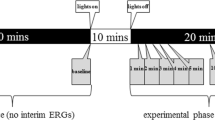Abstract
Normative dark-adapted electroretinograms were recorded simultaneously with a skin electrode and corneal electrode for varying stimulus intensities. The electroretinogram b-wave amplitudes for each electrode were fitted by the Naka-Rushton equation, and the parameters Vmax, K and n were evaluated. A comparison of parameters between the two electrodes showed a significant difference for Vmax and K but not for n. Vmax was approximately eight times smaller and K was 0.3 log unit smaller for the skin electrode than for the corneal electrode. B-wave amplitude and implicit time were also compared between the two electrodes. The b-wave amplitude ratio of the corneal electrode to that of the skin electrode increased with luminance and ranged from 1.83 to 7.68. Overall, b-wave implicit time for the skin electrode was approximately 10 ms shorter than that of the corneal electrode.
Similar content being viewed by others
Abbreviations
- CV:
-
coefficient of variation
- L-R function:
-
luminance-response function
- ND:
-
neutral density
References
Gouras P, Eggers HM, MacKay CJ. Cone dystrophy, nyctalopia, and supernormal rod responses: a new retinal degeneration. Arch Ophthalmol 1983; 101: 718–24.
Birch DG, Fish GE. Rod ERGs in children with hereditary retinal degeneration. J Pediatr Ophthalmol Strabismus 1986; 23: 227–32.
Birch DG, Fish GE. Rod ERGs in retinitis pigmentosa and cone-rod degeneration. Invest Ophthalmol Vis Sci 1987; 28: 140–50.
Johnson MA, Marcus S, Elman MJ, McPhee TJ. Neovascularization in central retinal vein occlusion: Electroretinographic findings. Arch Ophthalmol 1988; 106: 348–52.
Kaye SB, Harding SP. Early electroretinography in unilateral central retinal vein occlusion as a predictor of rubeosis iridis. Arch Ophthalmol 1988; 106: 353–56.
Breton ME, Quinn GE, Keene SS, Dahmen JC, Brucker AJ. Electroretinogram parameters at presentation as predictors of rubeosis in central retinal vein occlusion patients. Ophthalmology 1989; 96: 1343–52.
Naka KI, Rushton WAH. S-potentials from color units in the retina of fish (Cyprinidae). J Physiol 1966; 185: 536–55.
Wu L, Massof RW, Starr SJ. Computer-assisted analysis of clinical electroretinographic intensity-response functions. Doc Ophthalmol Proc Series 1983; 37: 231–39.
Aylward GW. A simple method of fitting the Naka-Rushton equation. Clin Vision Sci 1989; 4: 275–77.
Wali N, Leguire LE. On the method for fitting the Naka-Rushton equation: corrections to Aylward (1989). Clin Vision Sci 1990; 6: 79.
Birch DG. Clinical electroretinography. Ophthalmol Clin North Am 1989; 2: 469–97.
Tepas DI, Armington JC. Electroretinograms for noncorneal electrodes. Invest Ophthalmol 1962; 1: 784–86.
Jacobson JH, Uchida S, Masuda Y. Non-corneal electrodes for clinical electroretinography. Jpn J Ophthalmol (Suppl) 1966; 10: 204–11.
Noonan BD, Wilkus RJ, Chatrian GE, Lettich E. The influence of direction of gaze on the human electroretinogram recorded from periorbital electrodes: a study utilizing a summating technique. Electroencephalogr Clin Neurophysiol 1973; 35: 495–502.
Harden A. Non-corneal electroretinogram. Br J Ophthalmol 1974; 58: 811–16.
Nakamura Z. Clinical electroretinography from the skin. Acta Soc Ophthalmol Jpn 1975; 79: 42–49.
Jones RM, France TD. Recording ERGs and VERs from unsedated children. J Pediatr Ophthalmol 1977; 14: 316–19.
Giltrow-Tyler JF, Crews SJ, Drasdo N. Electroretinography with noncorneal and corneal electrodes. Invest Ophthalmol Vis Sci 1978; 17: 1124–27.
Uchida K, Mitsuyu-Tsuboi M, Honda Y. Studies on skin-electrode ERG in the closed-eye state. J Pediatr Ophthalmol Strabismus 1979; 16: 62–65.
France TD. Electrophysiologic testing and its specific application in unsedated children. Trans Am Ophthalmol Soc 1984; 82: 383–466.
Leguire LE, Rogers GL. Pattern electroretinogram: use of noncorneal skin electrodes. Vision Res 1985; 25: 867–70.
Kakisu Y, Mizota A, Adachi E. Clinical application of the pattern electroretinogram with lid skin electrode. Doc Ophthalmol 1986; 63: 187–94.
Sanita WG, Maggi L, Fioretto M. Retinal oscillatory potentials recorded by dermal electrodes. Doc Ophthalmol 1988; 67: 371–77.
Coupland SG, Janaky M. ERG electrode in pediatric patients: comparison of DTL fiber, PVA-gel, and non-corneal skin electrodes. Doc Ophthalmol 1989; 71: 427–33.
Harden A, Adams GGW, Taylor DSI. The electroretinogram. Arch Dis Child 1989; 64: 1080–87.
Arden GB, Carter RM, Hogg CR, Powell DJ, Ernst WJK, Clover GM, Lyness AL, Quinlan MP. A modified ERG technique and the results obtained in X-linked retinitis pigmentosa. Br J Ophthalmol 1983; 67: 419–30.
Ikeda H, Ripps H. The electroretinogram of a cone-monochromat. Arch Ophthalmol 1966; 75: 513–17.
Peachey NS, Alexander KR, Fishman GA. The luminance-response function of the dark-adapted human electroretinogram. Vision Res 1989; 29: 263–70.
Cringle SJ, Alder VA, Brown MJ, Yu DY. Effect of scleral recording location on ERG amplitude. Curr Eye Res 1986; 5: 959–65.
Aylward GW, Jeffrey BG, Billson FA. Normal variation and the effect of age on the parametric analysis of the intensity-response series of the scotopic electroretinogram, including the scotopic threshold response. Clin Vision Sci 1990; 5: 353–62.
Author information
Authors and Affiliations
Rights and permissions
About this article
Cite this article
Wali, N., Leguire, L.E. Dark-adapted luminance-response functions with skin and corneal electrodes. Doc Ophthalmol 76, 367–375 (1991). https://doi.org/10.1007/BF00142675
Accepted:
Issue Date:
DOI: https://doi.org/10.1007/BF00142675




